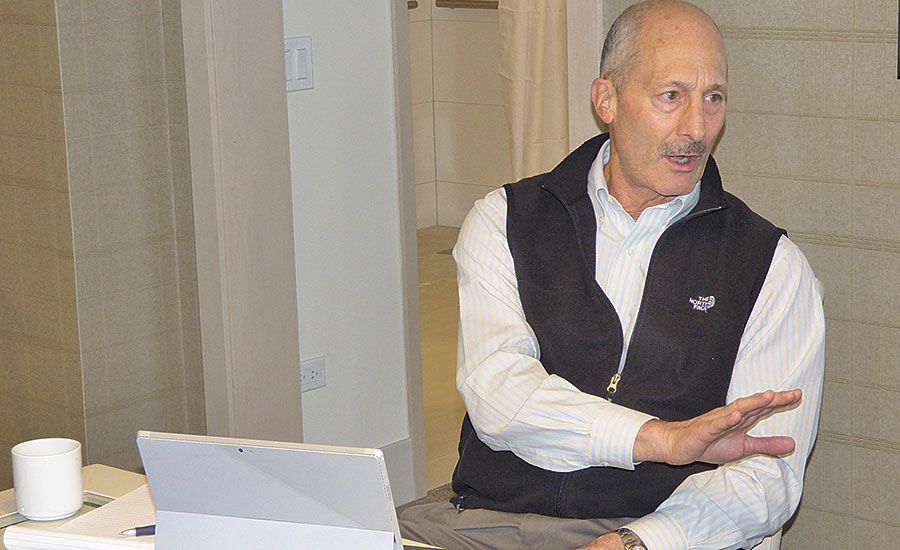Network2015 ASA Roundtable: Part 2
Back again with the second part of this exclusive interview from ASA’s record-breaking Network2015.

Supply House Times Editor Mike Miazga (center, window) conducts the sixth-annual Supply House Times/ASA roundtable interview in Chicago. Participants included, clockwise from near left: Steve Feiger, Bill Glockner, Gary Jones, Glenn Fuller and Patrick Sharp. Photo by Bob Miodonski/Supply House Times

Crawford Supply’s Feiger feels the industry is in a “longer-term deflationary cycle.” “It’s going to be a real grinding period and it could go two or three years,” he added. Photo by Bob Miodonski/Supply House Times

EPSCO’s Jones likes the direction ASA is headed. “The people in ASA are in it because they want to be in it and they want to better the industry,” he said. Photo by Bob Miodonski/Supply House Times

The roundtable panelists agree succession planning is a must for the continued health of a company. Photo by Bob Levy (www.rhlphoto.com).




Chicago’s Marriott Downtown Magnificent Mile was the site of the sixth annual Supply House Times/American Supply Association roundtable discussion in October during ASA’s record-breaking Network2015.
In the first part of this exclusive interview that ran in the January issue of Supply House Times, leaders from five prominent PHCP-PVF distributors discussed such topics as hiring practices, customer credit and relationships within the supply chain.
This time, distributors provide their candid thoughts on issues such as health care, succession planning, the current state of the economy and the evolution of ASA. The 2015 distributor roundtable panel included:
- Steve Feiger, CEO, Crawford Supply Group of Companies, Morton Grove, Ill.;
- Glenn Fuller, President/co-owner, Texas Plumbing Supply, Houston;
- Bill Glockner, President, Hirsch Pipe & Supply, San Juan Capistrano, Calif.;
- Gary Jones, Marketing Manager, Eastern Penn Supply Co., Wilkes-Barre, Pa.; and
- Patrick Sharp, Vice President, American Precision Supply, Hampshire, Ill.
Question: How is your company dealing with health-care costs and issues related to the Affordable Care Act?
Panelists agreed ACA has necessitated some extra planning sessions when it comes to their companies’ health-care plans and the benefits they provide employees.
“Whenever the government gets involved you have to lean on what they are doing,” Crawford’s Feiger explained. “Our plan was a pretty flush one and now it falls under the category of a Cadillac plan. Now you wrestle with the existing plans you have in place and where you are going to go from here. It is a much more strategic process. Ultimately the plan we will be offering is not going to be as rich as the plan we had. We’ve been able to mitigate some of that, but looking back on what we did five years ago and what we’re doing now, it’s different.”
EPSCO’s Jones said his company also has what is considered a premium product. “We’ve done some self-funding to try and keep the costs down for our employees and families,” he said.
In looking at ways to keep costs down for employees, Texas Plumbing Supply created a safety/health and wellness coordinator position. “We have weekly meetings at our locations that tie into safety and wellness,” Fuller said. “We educate our people on our insurance cost and coverage and help them realize how valuable it is. Health care is important. We want to treat our employees well and give them a good program. We care about our people.”
American Precision Supply offered its employees the choice of health-care coverage or a monetary contribution in lieu of that. “It was unanimous,” Sharp said. “They wanted health-care coverage. This is a very important benefit to them.”
Glockner said Hirsch Pipe & Supply takes pride in the coverage level it offers employees, but concedes the current health-care situation is challenging.
“One reason we get so many employees by referral is because of the benefits and security we offer,” he said. “We view our employees’ lifestyle and well-being as critical to our business. Adjusting to the changes in health care has been a challenge for us. We want to continue providing more extensive, benefit-rich coverage and the government seems to be working at odds with us. We’ve seen premiums go up and our carrier service levels decrease. Even though the carrier hasn’t changed, there are benefits that no longer are offered. In some cases, we’ve had to self-insure to cover the gaps.”
Question: How is succession planning playing into the future of your businesses?
Like health-care costs, the panelists have succession planning high on the to-do list. “Three of my six kids and my partner’s two sons-in-law are in the business,” Fuller said. “We don’t provide them any guarantees because we give everybody the same opportunity, but the future is something we all think about on a daily basis. I plan to be around for a long time, but you never know. You have to position your company to operate without you. That day could come tomorrow and you have to feel comfortable your business will be sustainable. I’m confident it is.”
Feiger noted he started looking at a succession plan with the company’s advisory board. That quickly turned into a broader-based look at the company’s future. “I looked at our organization chart and looked at my direct reports and their reporters and it was pretty stunning how I’ve worked with a lot of these people for 25 to 30 years,” he said. “For us, succession is an issue that starts at the top and works down deeply into the organization.”
Glockner had his eyes opened during a succession-planning exercise at an ASA meeting. “There is an age wave going through our business that we need to prepare for,” he said. “Our people have to understand an important part of doing a good job is identifying and developing the people who will replace them.”
Sharp revealed APS has a 10-year plan in place that eventually could involve a change to ESOP status. “We recruit people and tell them part of the succession plan could be employee ownership,” he said. “We feel it may be best to finance the employees — holding majority ownership while we mentor them toward ownership. We have hired several millennials we feel could potentially hold upper-management positions while working toward ownership.”
Fuller said a lack of succession planning can reveal an ugly side to the business. “Succession planning or lack of planning can be huge,” he said. “If someone comes to me that hasn’t planned for the future and wants to sell their company to me, there may be nothing left to buy and six months later they close the doors. Look at the business all the way through. Look at your people. They are your biggest asset. We tell people in our company they can’t move up until they have a replacement. That’s bottom-line business 101.”
Glockner stressed companies should be cognizant of issues such as estate taxes when going through a succession plan. “Be proactive and make sure your employee base is protected if there is an unexpected occurrence for the ownership group,” he said.
Question: What are your thoughts on the current state of the economy and where do you see it headed in the near future?
Sharp said business for APS in the Chicago, northern Illinois and Wisconsin region “was pretty flat” in 2015. “We feel the second and third quarter of 2016 will be better than 2015,” he added. “Projects bid to end users in 2015 that are normally awarded within 3-4 months now are taking 6-to-12 months for the approval cycle. I believe these jobs are funded, it’s just a matter of when the money will be released.”
Feiger feels the industry is in a “longer-term deflationary cycle.” “With a deflationary cycle you have to be more and more cautious with inventories,” he added. “I believe interest rates are going to stay low, which could be one indication of this deflationary cycle. As low as interest rates are now, you talk to younger people and it’s difficult to get a mortgage. It’s going to be a real grinding period and it could go two or three years.”
The panelists jokingly agreed they all should move their businesses to Texas where Fuller reports a better-than-normal business climate. “The Southwest is a good market right now for manufacturing, education and health-care facilities,” he said. “Of course we have oil, at least we used to. There still is a lot of decline there, but Texas is a big enough state where it can absorb that. Our apartment occupancies are very high and we have a positive population growth. We decided two years ago to go into commercial and we’re really starting to see the fruits of that start to happen.”
In recent times, ESPCO invested into the Marcellus Shale gas/oil field play primarily through its electrical division. “The entry into this division coincided with the housing and construction crisis and allowed us to survive a difficult time,” Jones said, “but within the last year or two that’s been down. We’ve tried to make up for that with commercial and residential construction. We always were in the commercial market but never formally in it. We now have a commercial team that concentrates on that market and lately that’s been a huge help. In general, that business is up for us over a two-year period, but the gas play still is struggling — thankfully we had that when we needed it.”
Glockner said the increased prevalence of e-commerce is affecting the economy. “E-commerce is disruptive in all industries,” he said. “We are seeing many retail chains start to struggle against e-commerce. It will be hard to have a lot of upward pressure on the economy if the retail job base is decimated in certain industries. I think it’s unlikely to see a big upswing in the economy in the near-term. It’s going to be more of a battle to maintain ground in your region.”
During this question, the discussion shifted to the various pieces of legislation that have affected the PHCP-PVF industry in recent years, including the Reduction of Lead in Drinking Water Act and the new efficiencies for water heaters (NAECA).
“Being based in California, it seems like we’ve had a permanent obsolescence team,” Glockner said with a laugh. “Every year there is some new legislated issue that we have to manage around and some chunk of our inventory likely will become obsolete because of it. We are afraid to guess what is it going to be next? I feel like our legislators believe they know more about the materials needed in plumbing products than manufacturing experts or research scientists.”
Jones vented about the low-lead law that went into effect in 2014. “We worked our tails off for 18 months to straighten that out and from what we have heard there hasn’t been a code person out there to enforce the code,” he said.
And then there are the requirements for the new 40-gal. water heaters. “The new ones don’t fit into many of the areas,” Feiger pointed out.
Glockner added: “We are seeing a lot of people consider tankless — one door closes and another opens.”
Fuller agreed distributors do benefit in some cases from new legislation, but he would like to see them get involved earlier in the process. “Distributors have a good future because of product changes like that,” he said. “As much as we talk about government, there are some things we do benefit from. However, we need to have a bigger voice earlier in the process. I know ASA has a new program designed to do just that in addition to its Government Affairs Committee that already has given distributors a voice in Washington, D.C.”
Question: What are your thoughts on the recent evolution of ASA and the current value proposition it brings to the table?
Glockner has seen ASA undergo a metamorphosis in recent years. “We’ve been ASA members as long as I can remember,” he said. “Sometimes, we felt like we were sending in the check just as a token of goodwill, but now the value is there. It’s exciting to see the work being done with education, advocacy and benchmarking. More suppliers are involved now and there are more networking opportunities available.”
For APS, the ASA Education Foundation and ASA University have been invaluable resources. APS CEO Teri Sharp currently is enrolled in the ASA University Masters of Distribution Management course. “What they’ve done with education in the last few years is tremendous,” Patrick Sharp says. “The education and market data are two areas we benefit from the most.”
Jones recalls standing in the registration line with Bradford White’s Bruce Carnevale in Chicago last October. “I turned to him and said when was the last time you had to wait in a registration line at an ASA meeting? ASA brings the best of the best together. It bonds the industry. The people who are in ASA are in it because they want to be in it and they want to better the industry whether they are a distributor, a rep or a manufacturer.”
Glockner added: It’s a no-brainer for someone to join ASA no matter what size distributor or supplier you are.”
This article was originally titled “Straight shooters: Part 2” in the February 2016 print edition of Supply House Times.
Looking for a reprint of this article?
From high-res PDFs to custom plaques, order your copy today!










